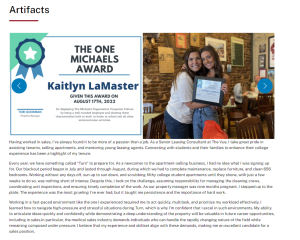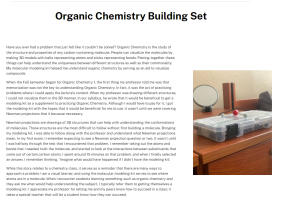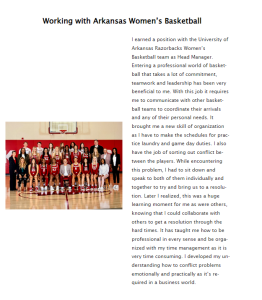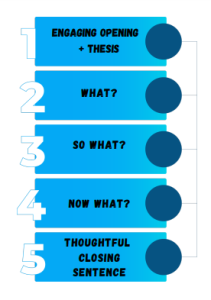15 Artifacts Samples for Discussion
Student Samples for Discussion
This page includes samples of students’ work. Evaluate the following student samples using the artifact reflection model.
- Can you identify the what, so what, and now what?
- Is the first sentence strong? If not, try rewriting it.
- What recommendations would you have for ways to fine-tune these artifact reflections?
- How might an employer view this artifact?
- Does the last sentence provide closure and end with powerful words?

The One Michael’s Award
by Kaitlyn LaMaster
Having worked in sales, I’ve always found it to be more of a passion than a job. As a Senior Leasing Consultant at The Vue, I take great pride in assisting tenants, selling apartments, and mentoring young leasing agents. Connecting with students and their families to enhance their college experience has been a highlight of my tenure.
Every year, we have something called “Turn” to prepare for. As a newcomer to the apartment-selling business, I had no idea what I was signing up for. Our blackout period began in July and lasted through August, during which we had to complete maintenance, replace furniture, and clean 656 bedrooms. Working without any days off, sun up to sun down, and scrubbing filthy college student apartments until they shone, with just a few weeks to do so, was nothing short of intense. Despite this, I took on the challenge, assuming responsibility for managing the cleaning crews, coordinating unit inspections, and ensuring the timely completion of the work. As our property manager was nine months pregnant, I stepped up to the plate. The experience was the most grueling I’ve ever had, but it taught me persistence and the importance of hard work.
Working in a fast-paced environment like the one I experienced required me to act quickly, multitask, and prioritize my workload effectively. I learned how to navigate high-pressure and stressful situations during Turn, which is why I’m confident that I excel in such environments. My ability to articulate ideas quickly and confidently while demonstrating a deep understanding of the property will be valuable in future career opportunities, including in sales. In particular, the medical sales industry demands individuals who can handle the rapidly changing nature of the field while remaining composed under pressure. I believe that my experience and skill set align with these demands, making me an excellent candidate for a sales position.

Organic Chemistry Building Set
by Lidia Belete
Have you ever had a problem that just felt like it couldn’t be solved? Organic Chemistry is the study of the structure and properties of any carbon-containing molecule. People can visualize the molecules by making 3D models with balls representing atoms and sticks representing bonds. Piecing together these things can help understand the uniqueness between different structures as well as their commonality. My molecular modeling kit helped me understand organic chemistry by serving as an aid to visualize compounds.
When the Fall semester began for Organic Chemistry 1, the first thing my professor told me was that memorization was not the key to understanding Organic Chemistry. In fact, it was the act of practicing problems where I could apply the lecture’s content. When my professor was drawing different structures, I could not visualize them in a 3D manner. In our syllabus, he wrote that it would be beneficial to get a modeling kit as a supplement to practicing Organic Chemistry. Although I would have to pay for it, I got the modeling kit with the hopes that it would be beneficial for me to use. It wasn’t until we were covering Newman projections that it became necessary.
Newman projections are drawings of 3D structures that can help with understanding the conformations of molecules. Those structures are the most difficult to follow without first building a molecule. Bringing my modeling kit, I was able to follow along with the professor and understand what Newman projections mean. In my first exam, I remember expecting to see a Newman projection question or two. It wasn’t until I was halfway through the test that I encountered that problem. I remember taking out the atoms and bonds that I needed, built the molecule, and started to look at the interactions between substituents that come out of certain carbon atoms. I spent around 15 minutes on that problem, and when I finally selected an answer, I remember thinking, ‘Imagine what would have happened if I didn’t have the modeling kit’.
While this story relates to a chemistry class, it serves as a reminder that there are many ways to approach a problem. I am a visual learner, and using the molecular modeling kit serves to see where atoms are in a molecule. When I encounter students learning something such as organic chemistry and they ask me what would help understand the subject, I typically refer them to getting themselves a modeling kit. I appreciate my professor for letting me and my peers know how to succeed in a class; it takes a special teacher who will let a student know how they can succeed.

Working with Arkansas Women’s Basketball
by Sagely Houghland
Rise Above Award
by Will Lambley
(For context, Will lost his sight in high school )
When the storms of life come the best thing to do is rise above. At my high school graduation in May of 2021, I was awarded the Rise Above award which is now awarded to a student every year in my honor. The Will Lambley Rise Above award is given to a student who has faced adversity at some point in their life with a positive attitude and a never-give-up mindset. Most importantly though a student who has used their adversity to help those around them.
Although this award is named after me, and I come back to my high school’s graduation every year to hand it out I never want it to just be about me. Rather it is about how no matter what we are facing in life with the right attitude and mindset we can always rise above adversity. Knowing that adversity will always come, but our response can always be greater.
My favorite part of this award is to see the surprise on the face of the person who gets it. This is because it reminds me that the award is not about me and how grateful I am that others get to be recognized as well. Which is why one of my favorite parts of every year is handing out this award. Knowing the storms of life will come but we can always rise above.
Stage in the Driscoll Cycle of Reflection |
|
Commentary |
| WHAT?
Our task was to complete a full-term assignment that required all team members to contribute and collaborate in order to be successful. The act of working in a group required that the work to be evenly distributed. Communication was key during the course of this assignment as [having] only one lecture a week, limited the amount of time we could communicate during class. Therefore, time outside of class was arranged to meet and complete the assignments to the best of our ability. |
The first paragraph describes the circumstances of the assessed activity or experience.
In other words, it addresses the “WHAT” portion of the Driscoll model. The author uses descriptive vocabulary and does not attempt to analyze or interpret the task. For example, the student writes “time outside of class was arranged to meet and complete the assignments to the best of our ability.” She makes no attempt to explain this activity or analyze its significance. Note, the “WHAT” section of the assignment represents the most basic form of reflection and serves only as a detailed recounting of an event (activity or exercise). There is limited reflective value in this paragraph other than its ability to record the details of what has transpired. However, a complete description is still essential in order to situate the paragraphs that follow. In other words, it is not possible to describe the impact of the activity or experience without first articulating in detail what they were.
|
|
| SO WHAT?
Teamwork has not always had a great impression on my academic career. However, this experience allowed me to be more open-minded towards group work. During this activity, I felt a greater sense of teamwork, collaboration and respect. Initially, I was not aware that the majority of the course would be based on teamwork. If I had known, I probably would not have taken or considered this course. My previous experiences with group work have been negative as I was usually the only one who actively wanted to succeed. Most of the workload was done by one person, and the entire experience was not fulfilling. However, this experience, was based on my lack of understanding of what constructive group work is really like. I had not considered the important role that collaboration plays in our growth as students and as people. In this course, group work was very effective and the work was not only evenly distributed, but students were able to appreciate the importance of collaborative learning. The professor had mentioned during the first lecture that collaborative learning is exceptional and can allow students to retain more information compared to individual studying. Moreover, during this course, group work was discussed and practiced regularly. |
The second paragraph provides the “SO WHAT” in Driscoll’s model of Reflective Practice.
It attempts to interpret or evaluate the description in the first paragraph. For example, in the first paragraph (Amber) the writer notes that the “task was to complete a full-term-assignment that required team members to contribute and collaborate.” In the second paragraph, the writer attempts to place this description of an activity or experience into a more meaningful context by stating that her previous experience with group work has been negative: “Teamwork has not always had a great impression on my academic career.” By connecting the described experience with these negative associations, the writer considers the SO WHAT. For example, the writer not only describes the experience as negative but provides evidence to support that claim: “Most of the workload was done by one person, and the entire experience was not fulfilling.” The evidence suggests that the work was not shared and was completed by a single group member. The result is problematic and the writer has identified that scenario as having contributed to her feeling unfulfilled. The writer goes on to add that “The professor had mentioned during the first lecture that collaborative learning is exceptional and can allow students to retain more information compared to individual studying.” Since one of the course’s themes is to provide collaborative learning opportunities, the frustration on the part of the student is palpable and relevant to the activity or experience. |
|
| NOW WHAT?
The experience of group work during this course has allowed me to develop and enhance my skills as a team player. The skills I have acquired are interdisciplinary and can be applied to my education in the future. Furthermore, being able to work collaboratively, problem solve and communicate in an effective manner are all skills that I can utilize in the coming years, despite the career I might pursue. Teamwork encourages the idea of each person pulling their own weight and working in an engaging and academic setting in order to benefit the entire group. For instance, if one were to become a surgeon and had encountered a difficult case which had an inconclusive diagnosis, teamwork would be essential. Multiple doctors would work together to problem solve by practicing the same skills learned in class to diagnose the patient in an accurate manner. |
In this last paragraph, the author has attempted to apply this activity or experience to a future learning opportunity and so has completed the “NOW WHAT” part of Driscoll’s model.
In this section she writes that “The skills I have acquired are interdisciplinary and can be applied to my education in the future.” This is a good example of how to link the present experience to a future context. This last section of the assignment represents the deepest form of reflection in which you attempt to apply your learning to something new. This is essential in order to maximize the benefits that result from the use of Reflective Practice. This is particularly apparent in this piece of writing when the author notes “Teamwork encourages the idea of each person pulling their own weight and working in an engaging and academic setting in order to benefit the entire group.” This is effective because she refers to the course concept of “teamwork” articulated in the previous section and then demonstrates through a specific example how knowledge of that concept could be applied in the future: “if one were to become a surgeon and had encountered a difficult case which had an inconclusive diagnosis, teamwork would be essential.”
|
|
|
|
||
Do You Have a Portfolio Example to Share?
We all benefit from having a variety of samples to examine. If you have an example that you think should be included in this book, email me at lmeade@uark.edu to let me know and complete this quick form to grant permission https://forms.office.com/r/LcFVDUPNF3.


